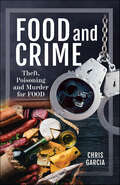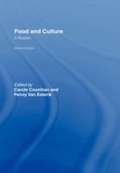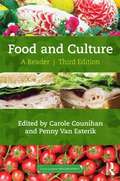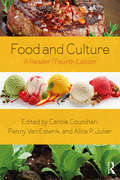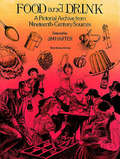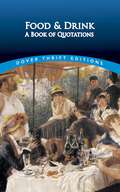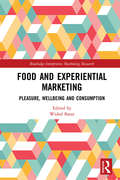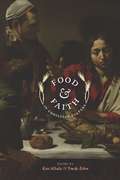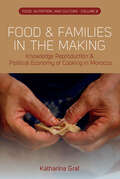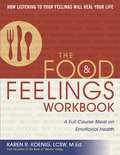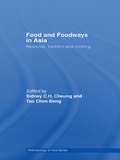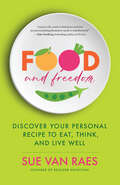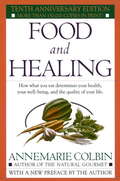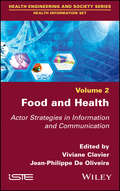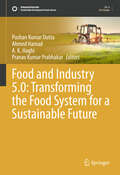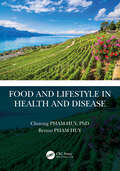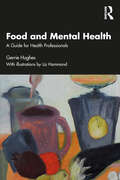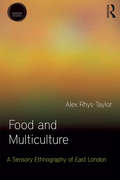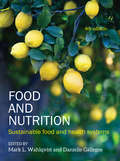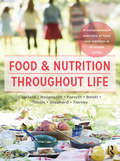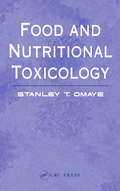- Table View
- List View
Food and Crime: Theft, Poisoning and Murder for Food
by Chris GarciaAnyone alive, and wanting to stay that way, must deal with food. Crime is, and always has been, present. Food and Crime examines the crossroads of these two universal forces, how hunger can lead to theft, fraud, and murder, and how the well-fed will sometimes do anything to keep their bellies full. From the one-timers to the career caper-planners, food criminals are a wide-ranging, often audacious bunch, and this is the record of their impact, great and small. From a war fought by the Mayor of New York over tasty thistles, to the role McDonald's plays in the American culinary conscious, to how foreign food aid abuse led to a mighty fall in the financial sector, these sixteen stories of criminals who engage with the world of cuisine, cookery, or agriculture cover food and crime from the piddliest pilfering to the most diabolical murders. Covering the period from the Ancient Greeks (who invented insurance fraud) to the effects of COVID-19 on seafood crime in the true crime capital of America - Florida, here's clear evidence that there's never been a time when food and crime were not intimately entangled. Food and Crime sheds light on the unexpected, and sometimes unbelievable, connections between two things that we can never seem to get enough of.
Food And Culture: A Reader
by Carole Counihan Penny Van EsterikFood and Culture: A Reader , is a solidly established classroom and reference text for scholars and students across the humanities and social sciences. It has been assigned in courses in anthropology, cultural studies, folklore, food studies, history, literature, philosophy, sociology, archeology, American studies, and more. Food and Culture remains significant because it demonstrates the centrality of cultural anthropology to the study of food. It is unique in providing an interdisciplinary collection of classic and cutting-edge articles in the field of food and culture studies that combine theory with ethnographic and historical data.
Food And Culture: A Reader
by Carole Counihan Penny Van Esterik<P><P>The classic book that helped to define and legitimize the field of food and culture studies is now available, with major revisions, in a specially affordable e-book version (978-0-203-07975-1). <P><P> The third edition includes 40 original essays and reprints of previously published classics under 5 Sections: FOUNDATIONS, HEGEMONY AND DIFFERENCE, CONSUMPTION AND EMBODIMENT, FOOD AND GLOBALIZATION, and CHALLENGING, CONTESTING, AND TRANSFORMING THE FOOD SYSTEM. <P><P> 17 of the 40 articles included are either, new to this edition, rewritten by their original authors, or edited by Counihan and van Esterik. <P><P> A bank of test items applicable to each article in the book is available to instructors interested in selecting this edition for course use. Simply send an e.mail to the publisher at companionaccess@informa.com.
Food and Culture: A Reader (Food In History And Culture Ser. #Vol. 1.)
by Carole Counihan Penny Van Esterik Alice JulierThis innovative and global best-seller helped establish food studies courses throughout the social sciences and humanities when it was first published in 1997. The fourth edition of Food and Culture contains favorite articles from earlier editions and several new pieces on food politics, globalism, agriculture, and race and gender identity.
Food and Drink
by Jim HarterThis monumental collection contains over 350 royalty-free illustrations of every conceivable activity concerned with the preparation and consumption of food and drink. Jim Harter, well-known commercial designer and collagist, has selected the most versatile and eye-catching material, mainly from rare nineteenth-century sources. These fine line drawings, reproduced sharply and clearly, comprise the most extensive and economical source of design material available.From the dining car of the Orient Express to the kitchen of an average family breakfasting at home, exotic and ordinary dining is shown in countries all over the world. There are rajahs dining in their palaces, cavemen squatting and eating with their hands, Romans feasting, wealthy families dining in elegant restaurants, public kitchens, servants, children eating, court scenes, Christmas dinners, dinner parties, individuals dining, banquets and cooks preparing meals, camping, and shopping.Not only are there activity scenes but also dozens of individual illustrations depict food, servers, and cooking utensils. A sampling includes: Exotic cakes and desserts, fish, melons, oranges, berries, grapes, artichokes, rhubarb, leeks, pumpkins, pigs, and turkeys Glassware, tea sets, decanters, mugs, pitchers, baskets, bowls, urns, flatware, candlesticks, servers, ladles, and rolling pinsThe wide scope of the book includes large illustrations as well as headings and vignettes suitable for wine lists, menus, cartes du jour, invitations, and many other uses. These royalty-free illustrations form a unique sourcebook -- virtually impossible to duplicate -- that can complement practically any point of reference on the subject of food and drink. Clearly reproduced from rare periodicals on high-quality stock, these pictures offer a limitless array of ideas for artists and designers of greeting cards, packaging, periodicals, and cookbooks, as well as collagists and decoupeurs.
Food and Drink: A Book of Quotations (Dover Thrift Editions: Speeches/quotations Ser.)
by Susan L. RattinerThis entertaining little book contains scores of thoughts, opinions, witticisms, and insights on two of the necessities -- and greatest pleasures -- of life. Included are humorous comments by Samuel Johnson ("A cucumber should be well-sliced, dressed with pepper and vinegar, and then thrown out.") and Henny Youngman ("My grandmother is over eighty and still doesn't need glasses. Drinks right out of the bottle."); incisive remarks by George Bernard Shaw ("Alcohol is the anesthesia by which we endure the operation of life.") and Mark Twain ("Eat what you like and let the food fight it out inside."); along with hilarious and frequently thoughtful advice from Robert Morley, G. K. Chesterton, W. C. Fields, Julia Child, Andy Rooney, Marilyn Monroe, Elsa Schiaparelli, and a host of other writers, humorists, and celebrities. Arranged according to subject (alcohol, cheese, cooking, fruits and vegetables, diet, hunger, etc.), this delightful collection will be welcomed by public speakers, speech writers, and general readers.
Food and Experiential Marketing: Pleasure, Wellbeing and Consumption (Routledge Interpretive Marketing Research)
by Wided BatatPleasure plays a significant but often neglected role in the creation of consumer wellbeing and the relationship between the food consumption experience and healthy eating. This innovative collection focusses on the experiential and hedonic aspects of food and the sociocultural, economic, ideological, and symbolic factors that influence how pleasure can contribute to consumer health, food education, and individual and societal wellbeing. Food and Experiential Marketing uses a holistic perspective to explore how the experiential side of food pleasure may drive healthy eating behaviors in varied food cultures. It questions: Is food pleasure an ally or an enemy of developing and adopting healthy eating habits? Can we design healthy offline and online food experiences that are pleasurable? What are the features of food consumption experiences, and how do they contribute to consumer wellbeing? Providing an overview of experiential and cultural issues in food marketing, this book will be invaluable for consumer behavior and food marketing scholars, public policy professionals, and the food industry in understanding the importance of pleasure in promoting healthy eating behaviors.
Food and Faith
by Norman WirzbaThis book provides a comprehensive theological framework for assessing significance of eating, employing a Trinitarian theological lens to evaluate food production and consumption practices as they are being worked out in today's industrial food systems. Norman Wirzba combines the tools of ecological, agrarian, cultural, biblical and theological analyses to draw a picture of eating that cares for creatures and that honors God. Unlike books that focus on vegetarianism or food distribution as the key theological matters, this book broadens the scope to include discussions on the sacramental character of eating, eating's ecological and social contexts, the meaning of death and sacrifice as they relate to eating, the Eucharist as the place of inspiration and orientation, the importance of saying grace and whether or not there will be eating in Heaven. Food and Faith demonstrates that eating is of profound economic, moral and theological significance.
Food and Faith in Christian Culture (Arts and Traditions of the Table: Perspectives on Culinary History)
by Ken Albala Trudy EdenWithout a uniform dietary code, Christians around the world used food in strikingly different ways, developing widely divergent practices that spread, nurtured, and strengthened their religious beliefs and communities. Featuring never-before published essays, this anthology follows the intersection of food and faith from the fourteenth to the twenty-first century, charting the complex relationship among religious eating habits and politics, culture, and social structure.Theoretically rich and full of engaging portraits, essays consider the rise of food buying and consumerism in the fourteenth century, the Reformation ideology of fasting and its resulting sanctions against sumptuous eating, the gender and racial politics of sacramental food production in colonial America, and the struggle to define "enlightened" Lenten dietary restrictions in early modern France. Essays on the nineteenth century explore the religious implications of wheat growing and breadmaking among New Zealand's Maori population and the revival of the Agape meal, or love feast, among American brethren in Christ Church. Twentieth-century topics include the metaphysical significance of vegetarianism, the function of diet in Greek Orthodoxy, American Christian weight loss programs, and the practice of silent eating rituals among English Benedictine monks. Two introductory essays detail the key themes tying these essays together and survey food's role in developing and disseminating the teachings of Christianity, not to mention providing a tangible experience of faith.
Food and Families in the Making: Knowledge Reproduction and Political Economy of Cooking in Morocco (Food, Nutrition, and Culture #8)
by Katharina GrafEven in the context of rapid material and social change in urban Morocco, women, and especially those from low-income households, continue to invest a lot of work in preparing good food for their families. Through the lens of domestic food preparation, this book looks at knowledge reproduction, how we know cooking and its role in the making of everyday family life. It also examines a political economy of cooking that situates Marrakchi women’s lived experiences in the broader context of persisting poverty and food insecurity in Morocco.
The Food and Feelings Workbook
by Karen R. KoenigAn extraordinary, powerful connection exists between feeling and feeding that, if damaged, may lead to one relying on food for emotional support, rather than seeking authentic happiness. This unique workbook takes on the seven emotions that plague problem eaters - guilt, shame, helplessness, anxiety, disappointment, confusion, and loneliness - and shows readers how to embrace and learn from their feelings. Written with honesty and humor, the book explains how to identify and label a specific emotion, the function of that emotion, and why the emotion drives food and eating problems. Each chapter has two sets of exercises: experiential exercises that relate to emotions and eating, and questionnaires that provoke thinking about and understanding feelings and their purpose. Supplemental pages help readers identify emotions and chart emotional development. The final part of the workbook focuses on strategies for disconnecting feeling from food, discovering emotional triggers, and using one's feelings to get what one wants out of life.
Food and Festivals: India
by Mike HirstINDIA Let your mouth water and your tastebuds tingle as you find out all about Indian food and festivals in this book. Did you know that throwing rice at newlyweds comes from a tradition at weddings in India? Choose which gifts of candies you would like to receive at the festival of Diwali. Try the festival recipes inside to taste the flavor of INDIA.
Food and Foodways in Asia: Resource, Tradition and Cooking (Anthropology of Asia)
by Sidney C.H. Cheung Tan Chee-BengFood is an important cultural marker of identity in contemporary Asian societies, and can provide a medium for the understanding of social relations, family and kinship, class and consumption, gender ideology, and cultural symbolism. However, a truly comprehensive view of food cannot neglect the politics of food production, in particular, how, when, from where and even why different kinds of food are produced, prepared and supplied. Food and Foodways in Asia is an anthropological inquiry providing rich ethnographic description and analysis of food production as it interacts with social and political complexities in Asia’s diverse cultures. Prominent anthropologists examine how food is related to ethnic identity and boundary formation, consumerism and global food distribution, and the invention of local cuisine in the context of increasing cultural contact. With chapters ranging from the invention of 'local food' for tourism development, to Asia's contribution to ‘world cuisine,’ Food and Foodways in Asia will be a fascinating read for anyone interested in the anthropology of food and/or Asian studies.
Food and Freedom: Discover Your Personal Recipe to Eat, Think, and Live Well
by Sue Van RaesEIGHT LIFE-CHANGING STEPS TO MAKE PEACE WITH YOUR PLATE After working with thousands of clients over two decades, functional nutritionist and food psychology specialist Sue Van Raes knows that food is not just about food. More than ever, our relationship with food highlights other areas of our lives that need our love and attention. Her eight-step system combines the latest science and psychology with practical guidance to help anyone learn to cultivate self-trust based on their bodily sensations and organic intelligence. Food and Freedom is a journey to reclaiming your wholeness and experiencing more mindfulness, personal fulfillment, and pleasure with food and in life. This trustworthy guide is rich with personal memoir, inspiring case studies from clients, soulful teachings, self-study prompts, nourishing recipes, and techniques to support biochemistry, satiation, and metabolic health. It will help you create body compassion and give you the confidence to show up in life as who you truly are, remedy emotional eating, and prosper with embodied self-care.
Food and Healing
by Annemarie ColbinTen years ago, Colbin's Food and Healing stood at the forefront of the food revolution, exploring the link between diet and health. In this anniversary edition, she provides updates on recent dietary systems, including low-fat, food combining, and alternative medicine.
Food and Health: Actor Strategies in Information and Communication
by Viviane Clavier Jean-Philippe De OliveiraFood is a major health issue; the links between diet and health are dominant in nutrition discourse and practice. Food and Health: Actor Strategies in Information and Communication identifies the informational practices of nutrition professionals and consumers to study the structural elements of food and health. It analyzes the communication strategies of actors and the dissemination and use of information related to both food for health and health through food. The book considers nutrition from the point of view of public policies, educational organizations, preventive measures, consumers and patients.
Food and Industry 5.0: Transforming the Food System for a Sustainable Future (Sustainable Development Goals Series)
by Pushan Kumar Dutta Ahmed Hamad A. K. Haghi Pranav Kumar Prabhakar"Food and Industry 5.0: Transforming the Food System for a Sustainable Future" offers a groundbreaking exploration of cutting-edge technologies reshaping the global food landscape. This comprehensive volume delves into innovations driving the fifth industrial revolution in food production and distribution. The book examines nanotechnology and biosensor applications in food processing and safety, analyzing their potential to revolutionize quality monitoring, extend shelf life, and enhance traceability. It unveils the transformative power of artificial intelligence and machine learning across the food value chain, from plant disease detection to sustainable poultry production. Significant attention is given to the integration of Internet of Things (IoT) and digital twin technology in agriculture and food supply chains, offering insights into real-time monitoring, predictive maintenance, and optimization techniques. The text explores robotics in food manufacturing, emphasizing advancements in efficiency, waste reduction, and safety. Crucial methodologies for quantifying and analyzing complex agricultural data are addressed, presenting both regression and classification approaches in precision agriculture. Sustainability is a key focus, with chapters examining nano-fertilizers, soil amendments, and AI-integrated crop systems designed to advance UN Sustainable Development Goals. Blockchain technology's role in enhancing food traceability and safety is investigated, complete with real-world case studies. The book addresses the complex regulatory landscape surrounding Industry 5.0 technologies, including waste management in hospitality and ethical considerations of AI deployment. Concluding chapters offer forward-looking analyses of emerging trends in dairy, diet, and hospitality subsectors. This meticulously researched volume employs a wide array of methodologies, from experimental studies to economic modeling and qualitative research. "Food and Industry 5.0" is an indispensable resource for food scientists, agricultural researchers, computer scientists, policymakers, and industry professionals. By bridging multiple disciplines, it provides a scientifically rigorous, data-driven roadmap for creating a more sustainable, efficient, and ethical global food system.
Food and Lifestyle in Health and Disease
by Chuong Pham-Huy Bruno Pham HuyThis book discusses various types of food and lifestyles for the prevention and treatment of diseases and disorders, including cardiovascular disorders, cancers, neurodegenerative diseases, diabetes, hypertension, and obesity. Discusses influences of environmental pollution, synergistic effects of different foods, and synergy of foods with physical activity or medicine. Provides examples of plant source foods, animal source foods, fungal source foods and explains their roles in human health and disease. Links the relationships between food, lifestyle and health.
Food and Mental Health: A Guide for Health Professionals
by Gerrie HughesWritten by an experienced psychotherapist, this book provides professionals in the fields of health and wellbeing with a guide to human relationships with food, and their impact on mental health. Acknowledging how food choices profoundly effect a person’s experience in the world, Gerrie Hughes offers knowledge and support around how to understand and negotiate the relationship between food and mind. Chapters offers facts, information and theories on key topics such as self-image, ‘good’ nutrition, sustainability and rituals. Each chapter uses vignettes, case studies and reflective activities to stimulate thought about the reader’s own assumptions and experience and offer approaches to how they might use their expertise with the people with whom they work. Providing an accessible and easy to read guide into the role food plays in our lives, this book will be of interest to a range of healthcare practitioners, including mental health nurses, occupational therapists, psychotherapists, and counsellors.
Food and Multiculture: A Sensory Ethnography of East London (Sensory Studies)
by Alex Rhys-TaylorIn this book, Alex Rhys-Taylor offers a ground-breaking sensory ethnography of East London. Drawing on the multicultural context of London, one of the most cosmopolitan cities in the world, he explores concepts such as gentrification, class antagonism, new ethnicities and globalization. Rhys-Taylor shows how London is characterized by its rich history of socioeconomic change and multiculture, exploring how its smells and food are integral to understanding both its history and the reality of London’s urban present. From the fiery chillies sold by street grocers which are linked to years of cultural exchange, through ‘cuisines of origin’ like jellied eels to hybridized dishes such as the chicken katsu wrap, sensory experiences are key to understanding the complex cultural genealogies of the city and its social life.Each of the eight chapters combines micro histories of ingredients such as fried chicken, bush-meat and curry sauce, featuring narratives from individuals that provide a unique, engaging account of the evolution of taste and culture through time and space.With its innovative methodology, this is a highly original contribution to the fields of sensory studies, food studies, urban studies and cultural studies.
Food and Nutrition: Sustainable food and health systems
by Janis BainesFood--how we produce, prepare, share and consume it--is fundamental to our wellbeing. It also connects the human body to the complex and dynamic systems of our environment. This is more significant than ever before in human history, as climate change and increasing population impact on global ecosystems.This fourth edition of Food and Nutrition has been completely rewritten to reflect an ecosystems approach to human health. It is shaped around four dimensions of human nutrition: biology, society, environment and economy. Food and Nutrition provides a comprehensive overview of food components and the biochemistry of foods and digestion. It outlines nutrition needs at different life stages, dietary disorders, and social and cultural influences on food selection and consumption. It also explores the increasing influence of technology on agriculture and food preparation, and recent research into intergenerational nutrition and nutrigenomics. At every stage it points to how you can impact your own health and the health of others as a global citizen and as a health or other food-system-related professional.Extensively illustrated with informative graphs, diagrams and data, and with examples, glossaries and reflective exercises, Food and Nutrition is the ideal introduction to the field of nutrition and dietetics for the 21st century, and a valuable professional reference for early career dietitians.
Food and Nutrition Throughout Life: A comprehensive overview of food and nutrition in all stages of life
by Catherine Itsiopoulos Adrienne Forsyth Regina Belski Antonia Thodis Sue Shepherd Audrey Tierney Sharon CroxfordNutritional requirements vary greatly according to age and lifestyle. This evidence-based, comprehensive text is a complete guide to eating habits across age and population groups. It provides the recommendations for intakes of nutrients and foods, and diet to achieve optimum health.Chapters systematically examine the nutritional issues for individuals from preconception, pregnancy and breastfeeding through to adulthood and old age. The text features an overview of dietary patterns by age group based on national scientific survey data together with the latest recommendations for optimum nutrition to maintain well-being and address specific health concerns. The final section examines nutrition issues for specific populations including indigenous groups, athletes and the disadvantaged. Throughout the text, key points are illustrated by case studies and the reader's knowledge is tested via quizzes and study questions.With chapters from leading nutrition researchers and educators in Australia, New Zealand and Asia, this is an excellent introduction to nutrition through the lifespan.'A comprehensive overview and detailed discussion of food and nutrition topics for all ages and stages of life.' - Robynne Snell, Curtin University
Food and Nutritional Toxicology
by Stanley T. OmayeFood and Nutritional Toxicology provides a broad overview of the chemicals in food that have the potential to produce adverse health effects. The book covers the impact on human health of food containing environmental contaminants or natural toxicants, food additives, the migration of chemicals from packaging materials into foods, and the persisten
